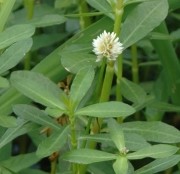 Alligator weed is a perennial native to South American but spread to many parts of the world including the US where it is invasive and considered a Federal Noxious Weed. It is especially common in the Southeast but can be found on coastal California and as far north as Illinois. Although it can grow on land areas such as ditches and marshes it is generally an emergent aquatic plant and forms large mats on the water that reduce water flow in waterways, cut light penetration and oxygenation of the water, and increase sedimentation.
Alligator weed is a perennial native to South American but spread to many parts of the world including the US where it is invasive and considered a Federal Noxious Weed. It is especially common in the Southeast but can be found on coastal California and as far north as Illinois. Although it can grow on land areas such as ditches and marshes it is generally an emergent aquatic plant and forms large mats on the water that reduce water flow in waterways, cut light penetration and oxygenation of the water, and increase sedimentation.
Description
The hallow horizontal stems of alligator weed can grow over thirty feet long and carry simple elliptical leaves two to four inches long. The small whitish papery flowers appear in late winter and spring. They are produced in dense clusters on two inch long stalks and resemble the flowers of clover. The seeds are rare and are not usually viable. Roots form at the nodes of the stems and new plants are easily and quickly produced from stem fragments.
Control
Alligator weed is very difficult to control either in water or on land and professional help is needed. The alligator weed flea beetle (Agasicles hygrophila), alligator weed thrip (Amynothrips andersoni) and alligator weed stem borer (Vogtia malloi) have been found to effectively reduce the problem. Manually removal of the weed from water can be more damaging than helpful because fragments are likely to produce more plants. Plants growing on land are usually treated with special herbicides.